Reserve Bank of Australia Annual Report – 2000 Financial System Stability
The RBA has a mandate to safeguard the stability of the Australian financial system. This responsibility is a longstanding one and was reconfirmed – and given sharper focus – in Australia's new financial regulatory structure, which came into effect from 1 July 1998. The division of responsibilities resulting from the Financial System Inquiry saw the establishment of the Payments System Board within the RBA to promote the safety and efficiency of the Australian payments system, and the transfer of responsibility for the supervision of banks in Australia to a new integrated regulator, the Australian Prudential Regulation Authority (APRA).
The smooth transition to these new regulatory arrangements has occurred against a backdrop of proven resilience in the Australian financial system and, over the past twelve months, more settled conditions in international financial markets. Australian financial institutions have continued to benefit from the long economic expansion and credit quality is high by historical standards.
Taking a longer sweep, the risks facing the Australian financial system have changed in nature over the past decade. In particular, financial markets have come to play a much more significant role in linking the decisions of savers and investors. Individuals, largely for retirement purposes, have built up substantial holdings of assets which earn market-related returns, and financial institutions now rely more heavily on wholesale financial markets to fund their balance sheet growth and manage their risks. While market vagaries can complicate the task of maintaining financial stability, other developments over this period – including improved risk management practices in financial institutions, a more sophisticated framework of prudential supervision and stronger underpinnings for the payments system – have enhanced the capacity of the Australian financial system to withstand financial shocks, whatever their source.
The RBA's Responsibility for System Stability
In pursuing its mandate for financial stability, the RBA's objective is to ensure that disturbances in any part of the financial system do not threaten the health of the economy more broadly. This task is closely linked to the Bank's monetary policy obligations and it draws on all its policy areas. The most important down-payment the RBA can make on financial stability is the maintenance of low and stable inflation. It can also contribute by ensuring a robust payments system, by monitoring changes in the patterns of financial intermediation and developments in financial markets, and by participating in various initiatives to strengthen the international financial architecture. In addition, it can, in extremis, make use of its balance sheet to support a fundamentally sound financial institution facing liquidity difficulties, if system stability is at risk.
Y2K
A first and unique test of Australia's new financial regulatory structure was the Y2K problem. Although technical in its origins, this problem had the potential to spark a loss of public confidence in individual financial institutions and, at worst, in the financial system as a whole. In developing a broad-based response, the RBA worked closely with APRA and the Australian Securities and Investments Commission (ASIC), under the auspices of the Council of Financial Regulators of which all three institutions are members.
The RBA's Y2K contingency planning included building up its buffer stocks of currency notes and announcing changes to its normal dealing operations to ensure that market liquidity did not come under pressure ahead of the date change; it also oversaw the testing of domestic payments systems. Over the final months of 1999, the priority was to reassure the Australian community that its deposits were safe from the Y2K problem and that it could have full confidence in the preparations of financial institutions. The RBA spoke to banks, building societies and credit unions about the need for clear communications with their customers about Y2K. It also took opportunities to reinforce the message that it would be ‘business as usual’ over the date change period. As that period approached, public opinion polling commissioned by the Bank suggested that the information campaign was working, with a clear majority of respondents not concerned about the impact of the Y2K problem on the financial system and satisfied with the reassurances received from their financial institutions. During December and early January, the RBA and APRA operated a joint communications centre in the Bank's Head Office to monitor Y2K developments in the financial system and co-ordinate briefings for Government, the media and overseas regulatory agencies.

As it turned out, the arrival of Y2K was virtually incident-free, a testament to the preparations by financial institutions and the regulatory agencies, and the good sense of the Australian community. As part of their preparations, banks purchased considerable additional currency notes from the RBA but, in the event, the public's demand for cash rose only moderately above the usual end-of-year peak, and financial institutions did not require additional liquidity assistance.
Co-operation with APRA
In other areas as well, co-operation between the RBA and APRA has proven effective, both at Board and operational levels. The RBA/APRA Co-ordination Committee, chaired by the RBA, has met on a regular basis to deal with a range of ongoing matters, such as the sharing of information and procedures for crisis management, and issues of particular interest; during 1999/2000, the latter included arrangements for the collection of financial data, and the level of public disclosure by authorised deposit-taking institutions (ADIs). The RBA is taking part in a major APRA project to improve the comprehensiveness and consistency of data obtained from financial institutions and to centralise their collection (except for payments data) by APRA; the Australian Bureau of Statistics is also closely involved in this project. The Co-ordination Committee has completed a preliminary assessment of public disclosure by ADIs in areas such as the structure of capital, risk exposures and capital adequacy. For listed Australian banks, the level of disclosure – though not the frequency – compares favourably with international standards, but disclosure by other institutions tends to fall short. The Co-ordination Committee will return to this issue in the context of proposals for improved disclosure of banks' capital adequacy and risk management strategies put forward by the Basel Committee on Banking Supervision, which is currently reviewing the 1988 Capital Accord. As part of the co-operation arrangements, RBA staff continued their occasional participation in APRA's on-site reviews of supervised institutions, to enable the Bank to stay attuned to changes in supervisory processes and risk management practices in financial institutions.
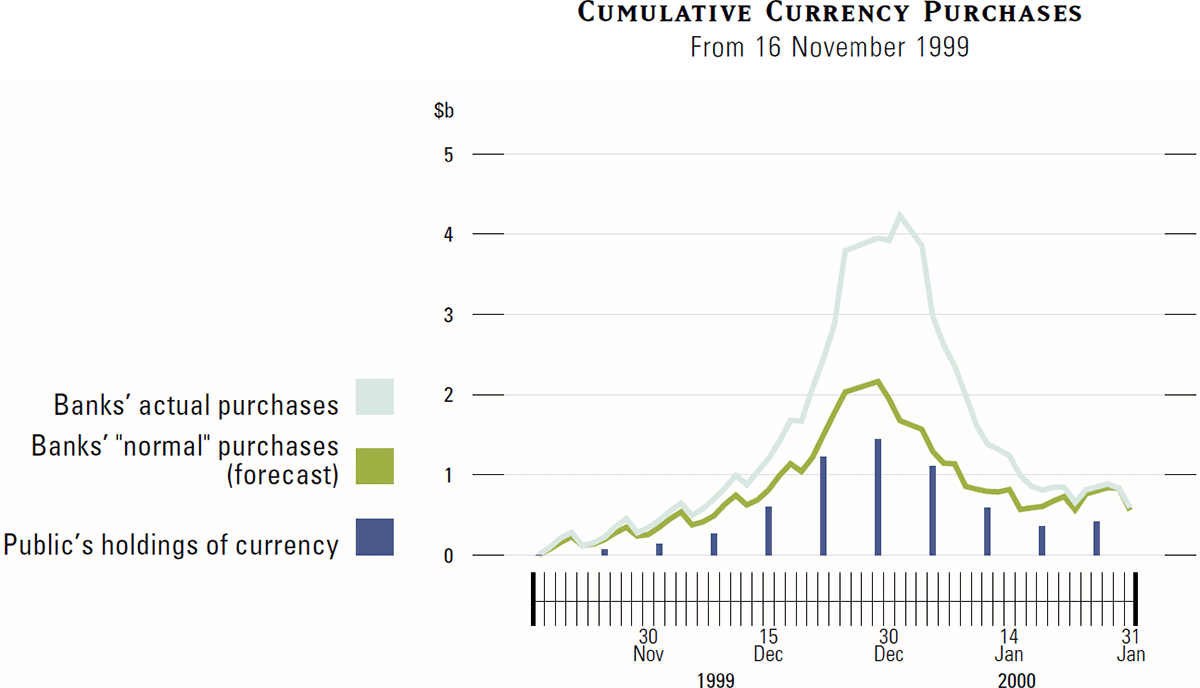
The Stability of the Australian Financial System
Recent Developments
During 1999/2000, the Australian financial system remained in healthy condition, a beneficiary of the long period of expansion in the Australian economy and a more supportive international environment. The global financial market turmoil and reduced appetite for risk of the previous year gave way to a recovery of confidence and a narrowing of credit spreads in global markets. However, a process of gradual monetary tightening in major economies has, over recent months, been associated with increasing volatility in share markets.
Although globally share prices have fallen from their recent peaks, and substantially so for technology stocks, share price valuations (relative to earnings) in the United States in mid 2000 remain high by historical standards. Any future US share market instability would probably flow quickly through to share markets in other countries and, if accompanied by large changes in global portfolio allocations, might lead to rapid realignments in currency markets. Sustained share market falls would also have a direct impact on financial institutions with share market exposures and, more generally, on wealth and confidence in the countries concerned. For these reasons, share market developments have the potential to threaten the stability of global financial markets over the period ahead.
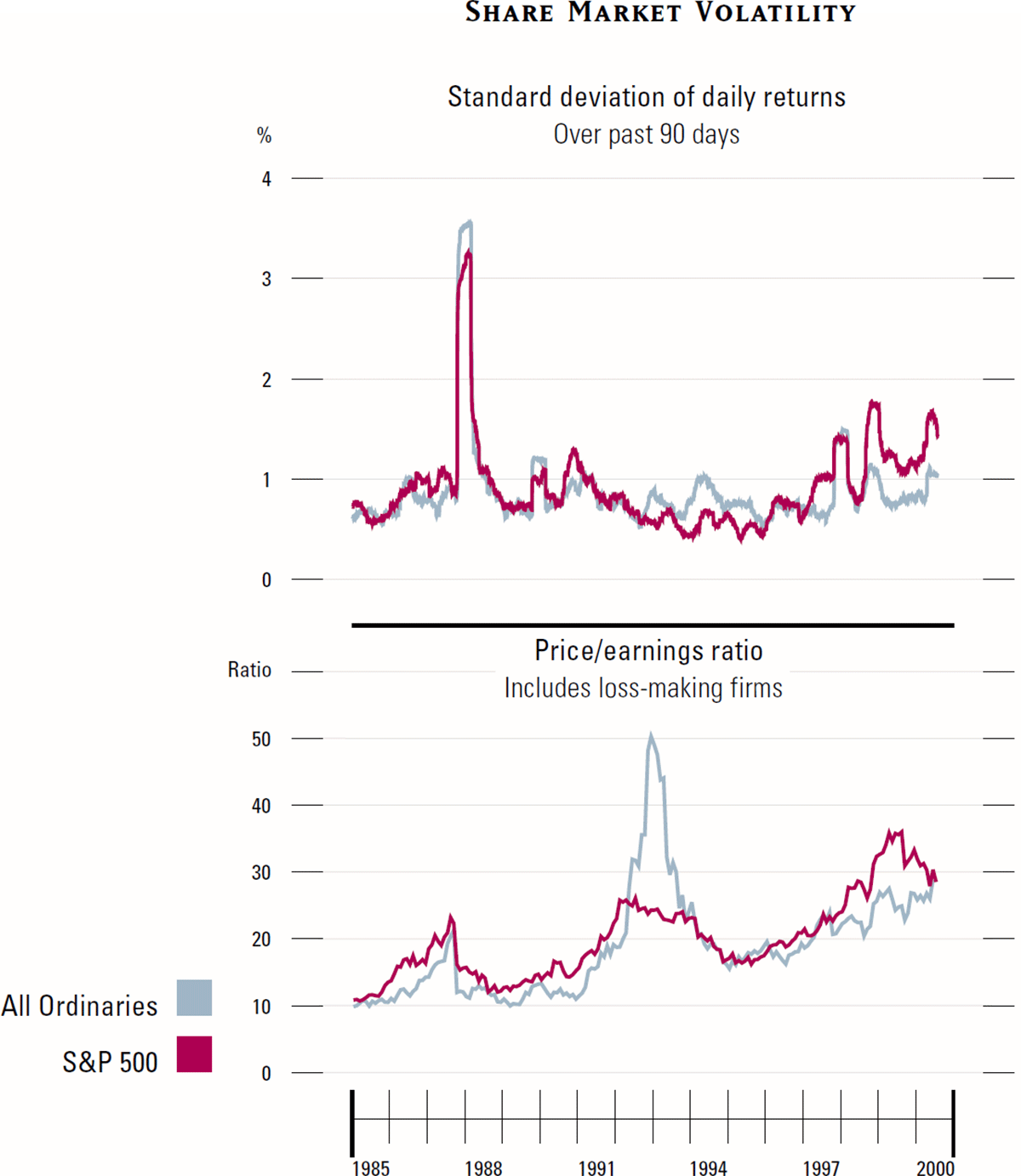
Continued rapid growth of credit was the major domestic development in the Australian financial system over 1999/2000, as it was the previous year. Credit extended by Australian financial institutions rose by 13.1 per cent. Within that total, credit to households grew by 17.5 per cent, well above its average over the past seven years and again outstripping growth in credit to business. The fundamental process at work over recent years has been the gearing-up of household balance sheets in response to the shift to a low-inflation environment and improved access to credit. While it is difficult to judge whether this process has further to run, recent rises in debt-servicing burdens might be expected to curb, to some extent, the willingness of households to assume additional debt.
One component of credit which has been growing especially rapidly, albeit from a small base, is margin lending for share purchases. Over the past year, margin lending by Australian financial institutions rose by 39 per cent. Because of the volatility of share prices, such lending is more risky than lending for housing and therefore carries a higher risk premium; margin loans are also typically limited to a maximum of 70 per cent of a portfolio of ‘blue chip’ stocks, and even less for other securities. Some lenders have responded to recent share market volatility by tightening their margin lending criteria. The RBA will continue to monitor developments in this area but, at around only one per cent of total credit outstanding, the level of margin lending is not considered a potential source of systemic risk.
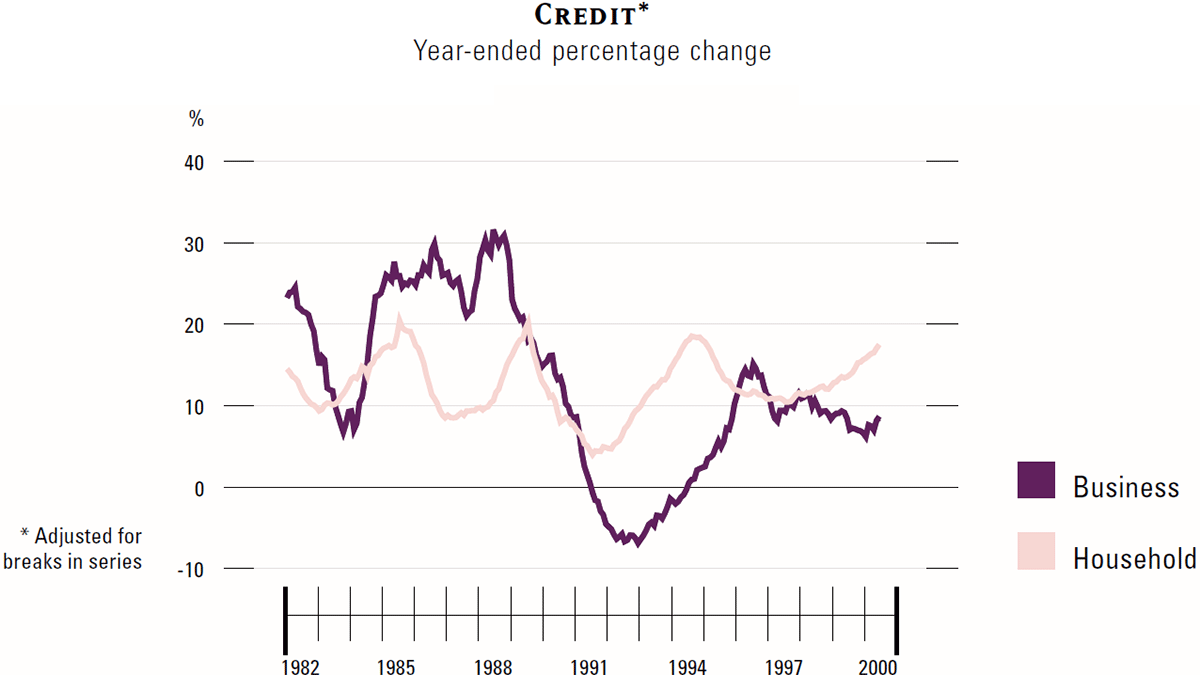
Notwithstanding further compression of interest margins over the year, banks have been able to maintain high levels of profitability as a result of significant asset growth, cost containment and further increases in non-interest income. For the major banks, non-interest income now accounts for around 40 per cent of total income, and this share is likely to increase further following recent acquisitions of fund management businesses by banks. Asset quality across the banking system remains strong, although the current ratio of impaired assets to total assets of around 0.6 per cent may prove to be a low point. After falling for a period, the profitability of building societies and credit unions has steadied over the past two years, with growth in non-interest income and favourable loan loss experience important contributors; however, cost reductions have proved more elusive for these groups.
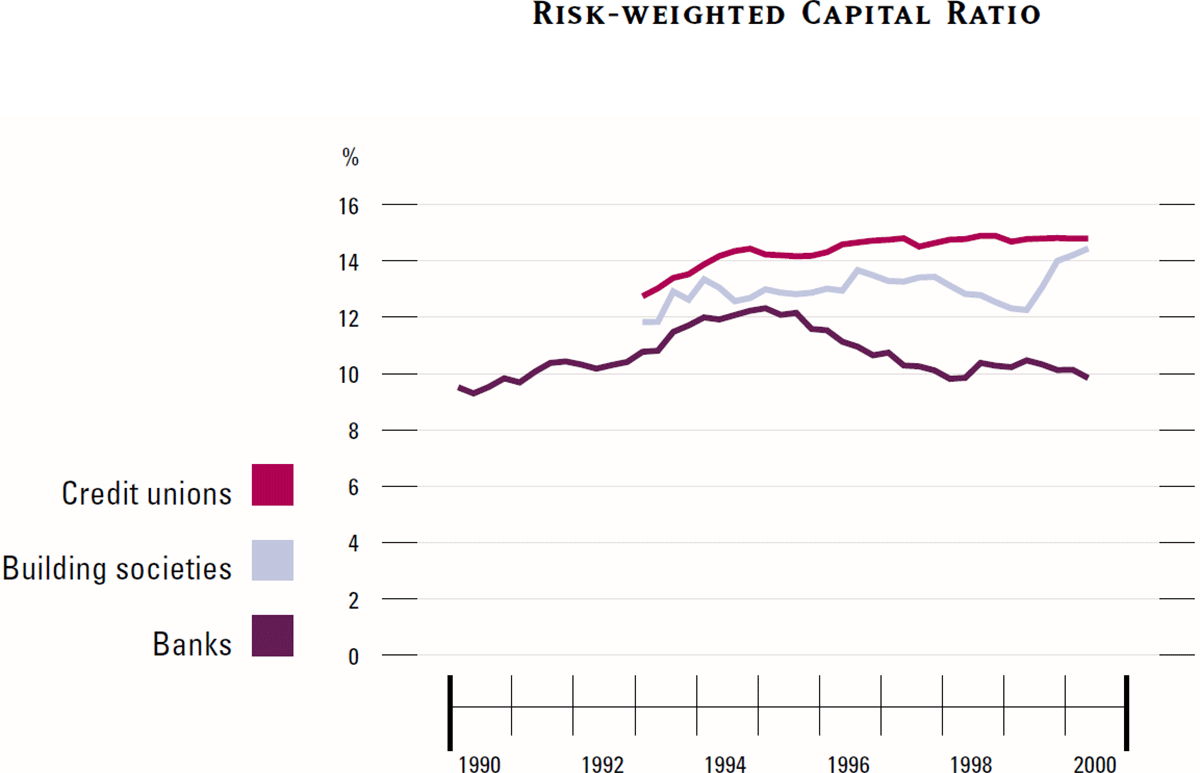
The capital ratios of banks, building societies and credit unions remain well above minimum required levels. The aggregate risk-weighted capital ratio for banks fell to 9.8 per cent by year-end, returning to early 1998 levels; earlier signs of an upward trend in general provisions for bad and doubtful debts have been reversed. Capital management by banks has become a much more active process with a number of banks conducting capital buy-backs in 1999/2000; over the period ahead, such management would call for care if indications of a deterioration in asset quality were to emerge.
The one area of the Australian financial system that has been under some stress is the reinsurance industry. A small number of Australian reinsurers with active international operations announced substantial losses as a result of a series of natural disasters in a number of countries, including Australia. The losses were borne by shareholders of these companies and, in some cases, by overseas creditors. However, they did not shake public confidence in the general insurance industry nor threaten overall financial stability. The prudential framework for general insurance is under review by APRA.
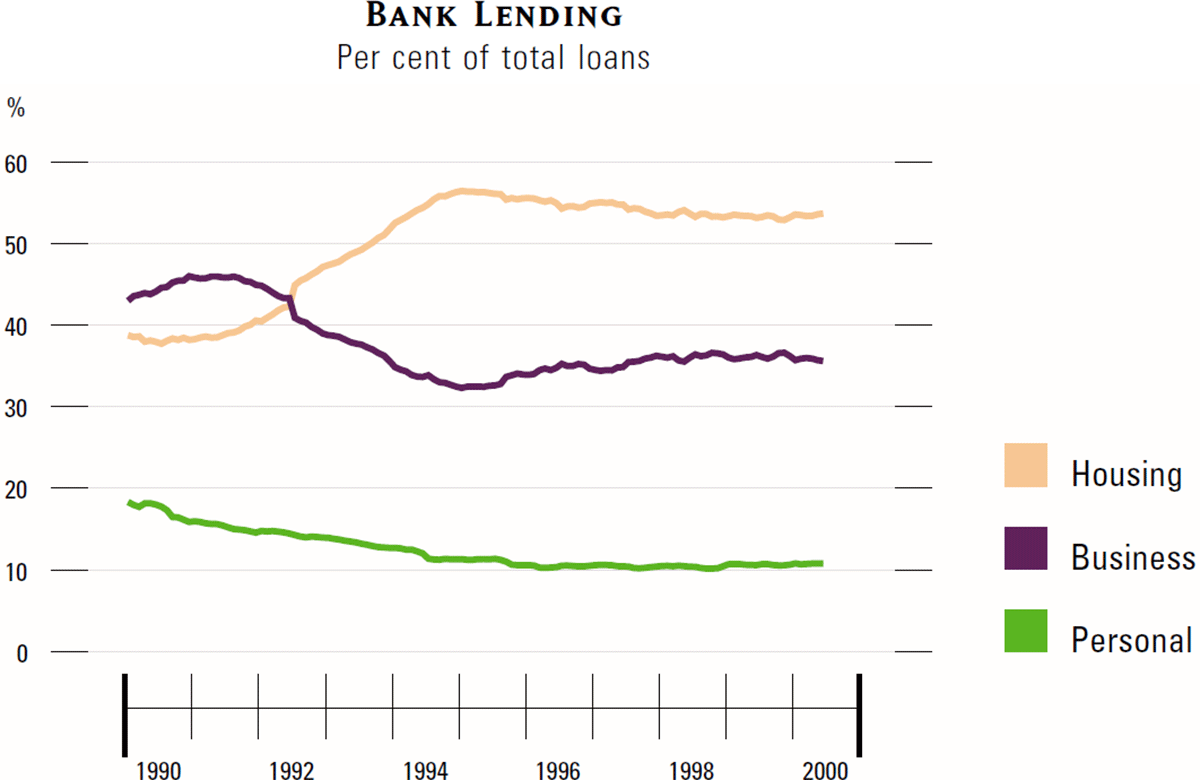
Longer-term Changes
Stepping back from contemporary influences, the current vigour of the Australian financial system is also the product of various structural changes that have played out over the past decade. Perhaps the most notable has been a general strengthening in the balance sheets of authorised deposit-taking institutions. The past decade has witnessed strong growth in credit to households, particularly for housing, but moderate growth in lending to business; high levels of corporate profits (after interest) and a buoyant share market have enabled businesses to make greater use of internal funding and equity raisings for expansion. For financial institutions, the consequence of these divergent credit trends has been a shift in the structure of assets towards lower-risk loans and, as a consequence, an improvement in average credit quality. This has been reinforced by the tendency of households to substitute home-equity loans for personal unsecured loans. Although some housing lending has been removed from banks' balance sheets through securitisation, the share of housing loans in total lending remains close to historical highs.
Another important structural change has been the growth in the wealth of the household sector and, within that, in its holdings of financial assets. These assets have increasingly taken the form of market-linked investments, such as superannuation and shares, while the relative importance of direct claims on financial institutions, such as deposits, has fallen. From the household sector's viewpoint, this deepening of balance sheets has decreased its relative exposure to the risk that financial institutions might fail but increased its exposure to changes in market prices.
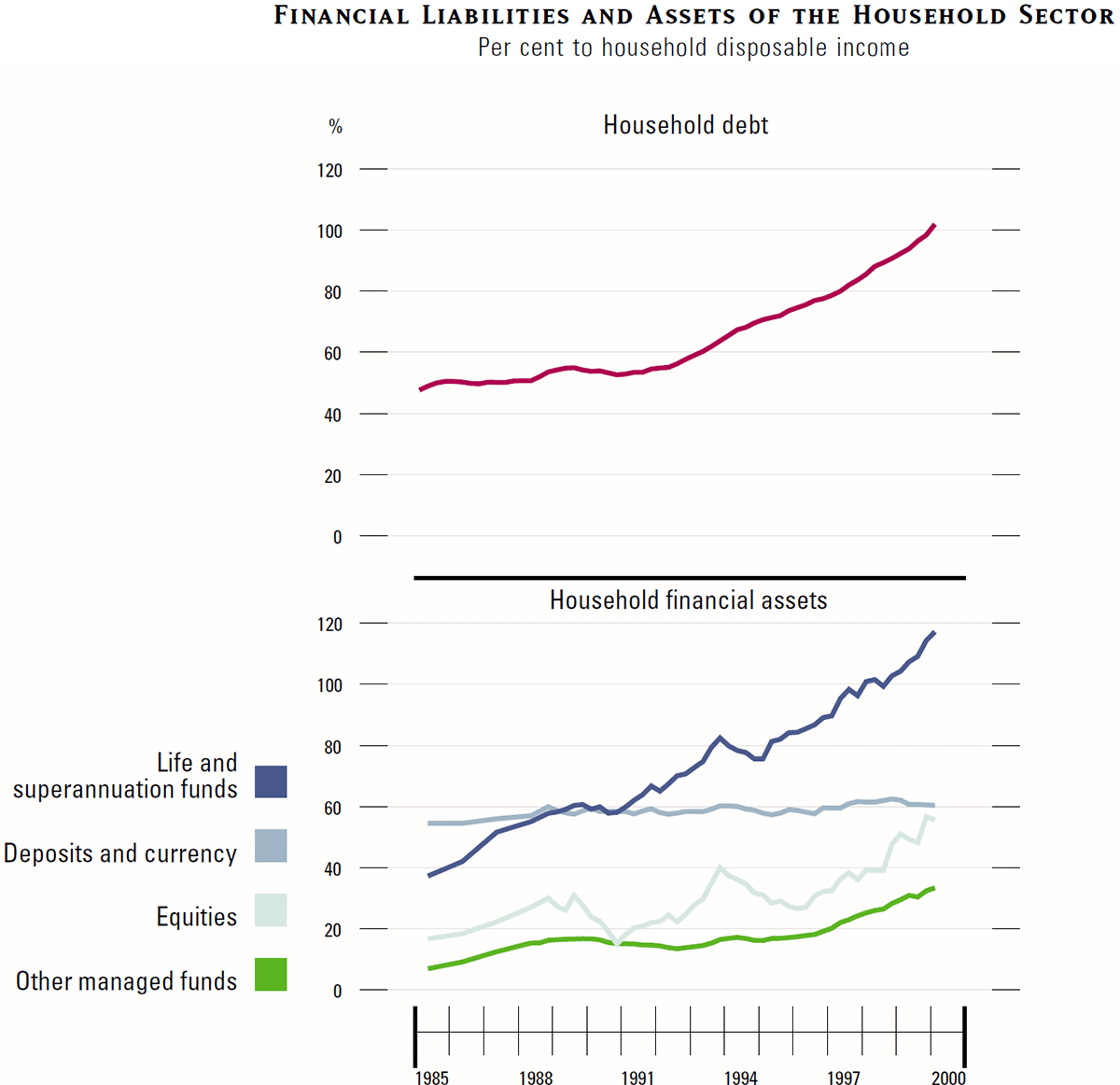
In the face of the household sector's reduced appetite for deposits, financial institutions, particularly banks, have turned increasingly to offshore wholesale markets to fund their balance sheet growth, mainly through issuing debt securities. Recourse to wholesale markets is part of a broader international trend for banks. Much of the offshore borrowing by Australian banks is denominated in foreign currencies and the associated currency risk is hedged, usually through the swaps market. Hence, Australian banks carry only small net foreign exchange exposures and, because they tap offshore markets on a reasonably continuous basis, are subject to close and ongoing market scrutiny.
To confront changes in the nature and complexity of their risks, authorised deposit-taking institutions have made a substantial effort to strengthen their risk management practices over the past decade. The improvements include an institution-wide focus on risk, the development of credit-grading systems and more sophisticated measurement and control of market-related risks. For these institutions, the obvious pay-off has been greater financial strength and a general firming in external credit ratings over the second half of the decade. The improvements are evident, for example, in the substantial fall in the value and number of credit exposures which are large relative to banks' capital. Another example is the better management of exposures to commercial property, where risk now tends to be measured on a portfolio basis rather than loan-by-loan. A third is the diversification of risks and income sources across financial sectors – as banks expand beyond traditional deposit-taking and lending businesses into funds management, life insurance and other fee-generating activities – as well as geographically; for the major banks, the share of profits generated overseas has risen over the decade from around 20 per cent to around 35 per cent.
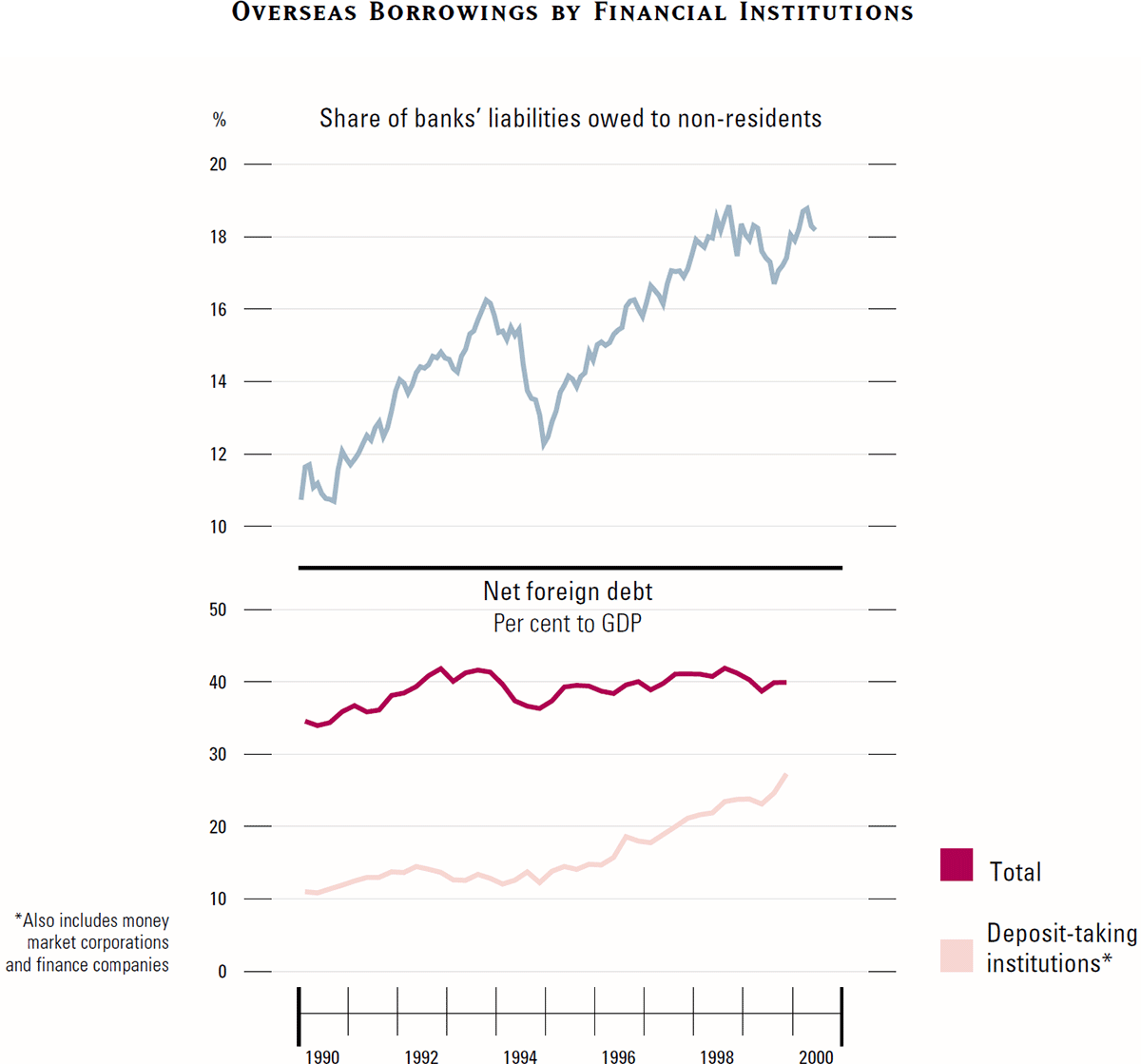
Complementing these improvements in risk management at the firm level has been a major strengthening of the Australian payments system, which has greatly reduced the risk that difficulties in one or more financial institutions might cascade through the financial system. The key reform was the introduction, in June 1998, of a real-time gross settlement (RTGS) system for high-value payments. This replaced a deferred net settlement system under which settlement obligations between banks accumulated over the course of the day and were not settled until 9.00 am the next morning. The deferred nature of settlement left open the possibility that a bank might be unable to meet its obligations, putting other institutions under severe liquidity and even insolvency pressures. The RTGS system eliminates this risk by ensuring that settlement obligations arising from high-value transactions are extinguished at the same time as the transactions are completed. The RTGS system settles over 90 per cent of payments (by value) exchanged between financial institutions in Australia and it has taken Australia to world's ‘best practice’ in this area.
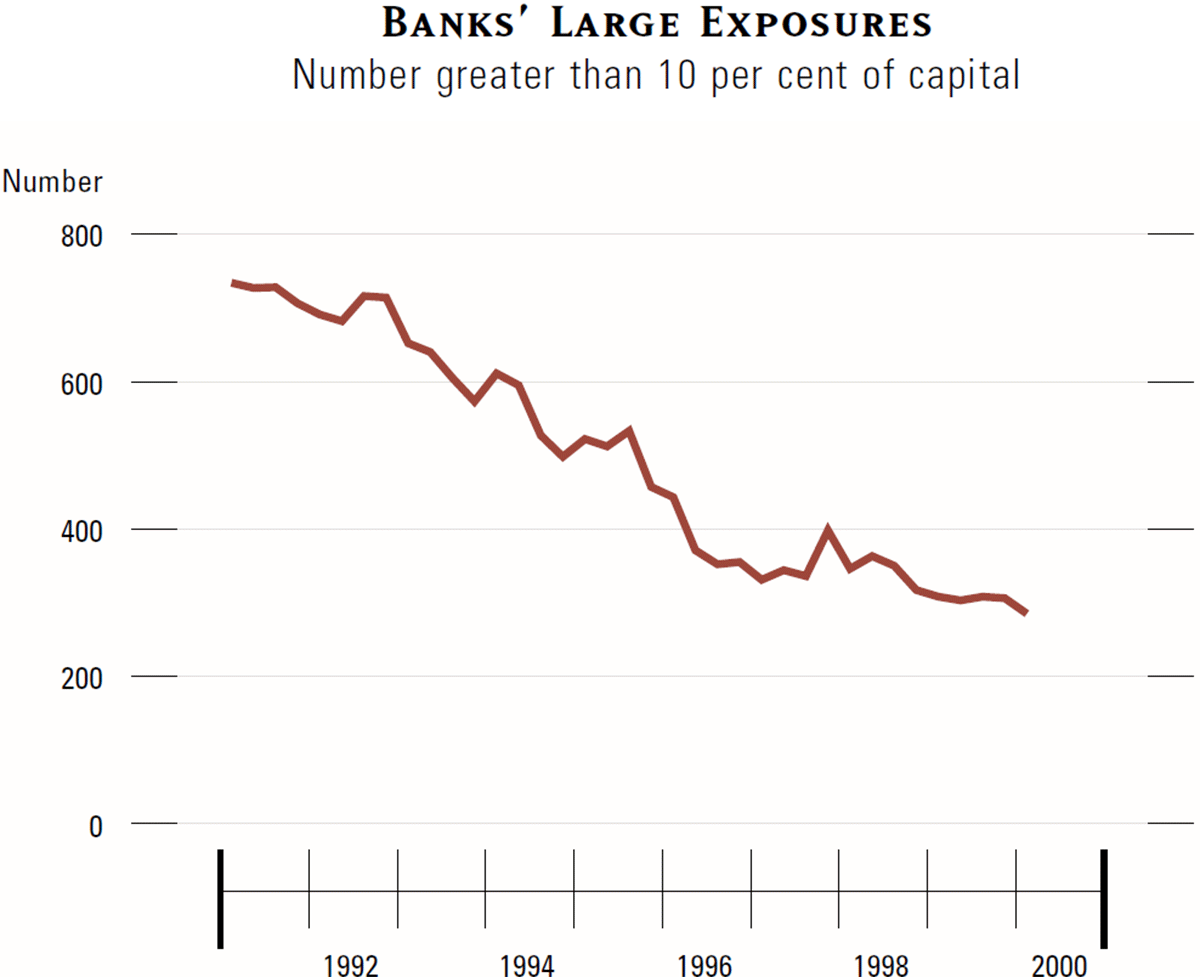
Important though the focus on financial institutions is, any assessment of financial stability must also acknowledge that financial markets now account for a rising share of financing activity. One expanding market supplementing traditional intermediation is the market for asset-backed securities, particularly mortgage-backed securities, which has grown over the past decade to the equivalent of almost 10 per cent of total credit outstanding. Assets of the listed property trust sector have also been rising rapidly. Increasingly, commercial property developments are being funded through such trusts, ensuring that there is a timely, market-based assessment of conditions in the commercial property sector. More generally, business has turned to new equity issues on the Australian Stock Exchange as an important source of finance. While the long-term corporate bond market has also expanded, institutions outside the financial sector have made only limited use of this market to date.
Whether the more pervasive role which financial markets now play has changed the overall level of risk in the Australian financial system is moot. Recent overseas experience suggests that financial disturbances are increasingly likely to originate in, and be transmitted through, financial markets. However, experience also shows that, provided the financial system itself is robust, market-related disturbances can be handled through prompt policy responses and can have a less severe impact on the macroeconomy than the failure of financial institutions. The growth of financial markets also provides a more diverse range of financing options, making the economy less susceptible to difficulties in any one part of the financial system. In addition, financial markets give businesses and households greater scope to manage their risks. Whatever the balance of these various impacts, it is clear that avoiding excessive speculation in asset markets, financed either through traditional intermediation or market-related debt, is critical to ensuring financial stability.
Payments System Developments
The Payments System Board of the RBA has responsibility for the safety of the Australian payments system and for promoting efficiency and competition within that system, consistent with overall financial stability. The Board oversees the RBA's new and comprehensive powers in this area which allow it, amongst other things, to determine rules for participation or set standards for safety and efficiency in a particular payment system. To date, the RBA has made only limited use of these powers, preferring to work co-operatively with payments system participants, as the new regulatory regime envisaged.
While the safety and robustness of the domestic payments system scores highly against emerging international norms, particularly with the introduction of the RTGS system, further progress is needed in reducing foreign exchange settlement risk. The Payments System Board has strongly supported a global initiative – the ‘continuous linked settlement’ or CLS Bank – to reduce such risk through the simultaneous settlement of participants' foreign exchange transactions in eligible currencies, which will include the Australian dollar.
On the efficiency front, the Board has focused its attention on the pricing and other incentives for using different types of payment instruments. The current incentives are encouraging the use of credit cards over more efficient and less costly alternatives, such as direct debits for regular bill payments. The RBA has been conducting a joint study with the Australian Competition and Consumer Commission into interchange fees and access criteria in the debit and credit card markets, to determine whether current arrangements are conducive to the efficient provision of card services. The findings of the joint study will be released shortly. In addition, the Board has been working closely with major billing institutions to develop consumer safeguards which might encourage greater acceptance of direct debits in Australia. The Board has continued to encourage banks and other financial institutions to speed the availability of cheque funds to what is now clearly ‘best practice’ of three days. The Board's activities will be described in its second Annual Report to be published in October.